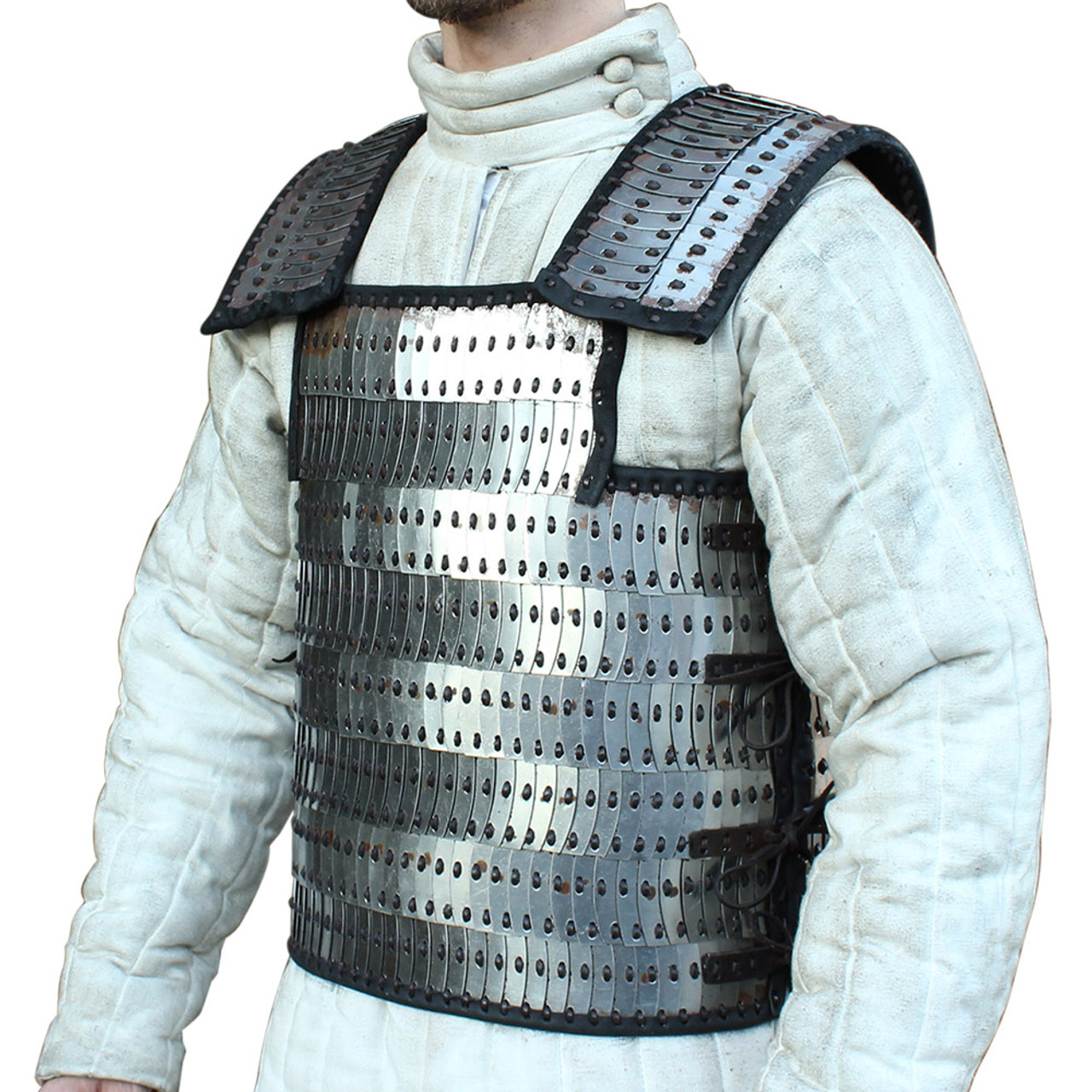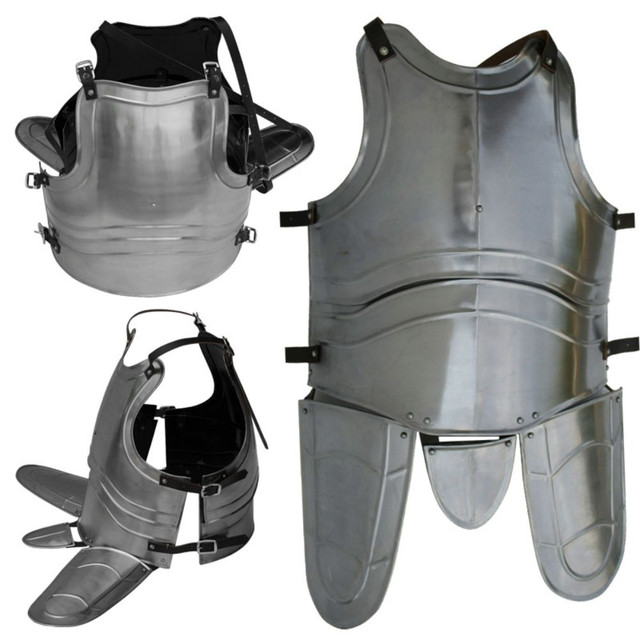The Coolest and Most Effective Medieval Body Armor
Posted by Swordsswords on Feb 20th 2024
Every history buff knows that medieval armor was the difference between life and death on the battlefield. It shaped not only warfare but also social hierarchy and cultural ideals. But "best" medieval knight armor wasn't a simple title. Was it the chainmail's flexibility, the plate's stoic defense, or something else entirely?
In this blog, we will delve into the fascinating world of medieval armour, exploring its evolution. We will evaluate its effectiveness based on protection, mobility, and cost. and ultimately revealing the truth: the "best" medieval knight armour. Prepare to be surprised, informed, and maybe even a little inspired by the ingenuity and craftsmanship of these historical marvels.
Types of Early Medieval Armors
The early Middle Ages saw a diverse array of warriors clad in fascinating armour. Let's unravel the history of body armor and examine 3 main types:
1. Lamellar Armor (around 400 AD): This functional body armor had overlapping scales of metal, sewn onto fabric or leather. This versatile, lightweight choice offered decent protection against slashing swords but not so much for arrows. Popular among mounted warriors, its flexibility allowed for agile movement, unlike its later, stiffer cousin – plate armour.
2. Chainmail (Hauberk) around the 5th century AD: The iconic "medieval knight in shining armour" image often depicts this marvel of craftsmanship. Interlocking iron rings formed a flexible yet strong barrier. It could easily deflect swords and arrows with remarkable effectiveness. But chainmail wasn't perfect. Blunt force weapon like maces could still deliver bone-jarring blows. Also, the cost and production time made it a luxury item.
3. Leather Armor (400-1500s): Hardened leather also served as a readily available and tougher body armor. Boiled leather could offer protection against swords, making it ideal for foot soldiers and archers. Its affordability and ease of repair further solidified its place in early medieval armour. However, this full body armour's vulnerability to moisture and piercing weapon limited its use in high-stakes battles.
These functional medieval armour, each with unique strengths and weaknesses, paint a captivating picture of medieval ingenuity. While none were invincible, they were vital tools that shaped the battlefield and warrior culture of the era.

The Rise and Dominance of Plate Armour
The Age of Chivalry(11th-15th centuries) witnessed a revolution in protection with the rise of plate armour. But its journey wasn't an overnight success. Let's dissect the strengths and weaknesses of 3 key players in the:
1. Gothic medieval Armour (13th-15th centuries): This knight's body armor had warriors encased in interlocking plates, offering unparalleled protection against swords and piercing attacks. This was the hallmark of Gothic plate, emerging in the 14th century. While heavier than its predecessors, it provided superior defense, making knights virtually impenetrable on the battlefield. However, its inflexibility hindered mobility, and the cumbersome weight limited combat effectiveness.
2. Maximilian Plate Armor (1470s-16th century): Enter the 16th century and the sleek, sophisticated Maximilian style. Inspired by Roman armor , it offered improved mobility while maintaining robust protection. Strategically placed rivets and articulated plates allowed for better movement, making this iteration ideal for horseback combat and jousting. However, its intricate design increased production costs, making it accessible only to the wealthiest warriors.
3. Brigandine (14th-16th centuries): Brigandine offered a budget-friendly alternative, using overlapping metal plates riveted onto a padded fabric core. It provided decent protection against slashes and arrows, though blunt force remained a concern. Its affordability made it popular among foot soldiers and archers, offering a balance between cost, mobility, and protection.
Specialized Modern Armour in Action
While plate armor ruled the battlefield, specialized styles emerged for unique combat roles:
1. Jousting Armor: This functional body armor was like a fortress of steel. Jousting modern armor was specifically designed for the brutal sport of mounted combat. Its unique features included:
- Heavier construction: Built to withstand the impact of lances, this armor often sacrificed mobility for maximum protection.
- Reinforced chest and great helm: Designed to absorb the direct hit of a lance, these areas were significantly thicker compared to standard plate armor.
- Large lance rest: Attached to the right shoulder, this allowed the knight to control the lance effectively during the charge.
- Limited mobility: While offering incredible protection, the bulky design significantly restricted movement compared to standard plate armor.
2. Archer's Armor: Unlike their heavily armored counterparts, archers needed agility and freedom of movement. Their armor reflected this need, sporting unique adaptations like:
- Lighter construction: Focusing on vital areas like the chest and arms while leaving limbs relatively exposed to maintain agility.
- Lamellar or brigandine construction: These offered decent protection while being lighter and more flexible than full plate.
- Sallet medieval helmets: Open-faced design provided excellent peripheral vision crucial for targeting enemies.
- Small arm guards: Often segmented or absent entirely to allow for unrestricted bow-drawing and aiming.
Difference between plate, jousting armor and archer’s armor: While plate armor dominated battlefields, jousting armor prioritized blunt force resistance, while archer's body armour focused on mobility and dexterity. These specialized styles demonstrate the importance of adapting protection to specific functions.
Evaluating the True Effectiveness of Medieval Armor
Judging the "best" medieval body armour isn't a simple task. It's like comparing apples and oranges, as each type excelled in different areas. Let's delve into the key criteria that truly defined effectiveness:
1. Stopping Power: The ultimate goal – withstanding enemy attacks. Different armors fared differently against various weapon:
- Swords: Chainmail excelled at deflecting slashes, while plate armor offered near-impenetrable defense. Leather, however, struggled against both.
- Arrows: Plate armor, particularly later styles, could deflect arrows. Lamellar offered decent protection, while leather's effectiveness depended on thickness and treatment.
- Maces and blunt weapon: Even plate armor, while strong, couldn't fully mitigate the bone-jarring impact. Chainmail and leather offered less protection against blunt force.
2. Freedom to Move: A warrior needs agility to fight effectively. This is where the trade-off arises:
- Plate armor: While offering supreme protection, its weight and inflexibility often limited mobility and stamina.
- Chainmail: More flexible and allowing for faster movement, it still restricted agility compared to lighter options.
- Leather and lamellar: These offered varying degrees of mobility depending on design, often surpassing chainmail in nimbleness.
3. The Weight of Protection: Carrying around heavy metal wasn't easy. Consider:
- Plate armor: The heaviest option, it took considerable strength and endurance to wear effectively.
- Chainmail: Still substantial, it wasn't as cumbersome as plate, allowing for longer periods of activity.
- Leather and lamellar: Significantly lighter, these enabled greater speed and agility on the battlefield.
4. Cost and Production: Remember, affordability played a vital role:
- Plate armor: Expensive and time-consuming to craft, it remained primarily accessible to nobility and wealthy knights.
- Chainmail: While still costly, its widespread use indicates a more attainable option compared to plate.
- Leather and lamellar: The most economical choices, they were often adapted and repaired locally, making them widely available.

The Verdict
So, what was the "best" functional medieval armor ? In truth, there wasn't one answer. It depended on the warrior, the weapon, and the battlefield. Plate offered stoic defense, chainmail agile flexibility, leather affordability, and brigandine a practical balance. Each served a purpose, a testament to the ingenuity and diverse realities of medieval warfare.
But the story doesn't end there. These marvels continue to inspire, sparking historical reenactments and captivating audiences in movies and games. Want to experience the thrill of owning a piece of history? Explore the vast collection of medieval armor at swordsswords.com! From chainmail shirts to brigandine vests, find your perfect piece to step into the past.

